This post started as just a quickie, because I happened to find a vintage photo of a couple French WWI soldiers using a crossbow/ballista type device to throw grenades. I realized, looking at the photo, that I’d actually seen one of them in person, as the Paris Musée de l’Armée. The plan was to post the vintage photo along with my recent photo, but I started trying to research more about the device, and ended up several hours later with a lot more information than I’d planned on.
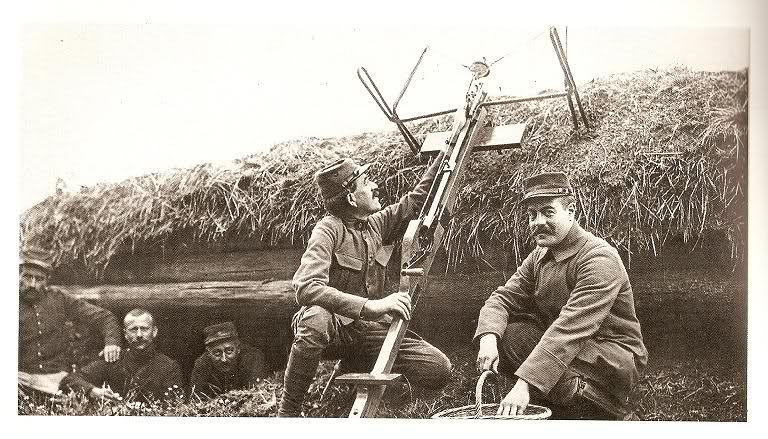
The device was called L’Arbalete la Sauterelle Type A D’Imphy, and it quite literally was a crossbow, using the tension of two bent steel rods to provide the energy storage that sinew provided back when the Romans were building this sort of thing. A metal cup held a spherical Type 14 grenade (weight roughly 1kg/2.2lb), and a pair of hand cranks on a rack and pinion mechanism were used to cock it.
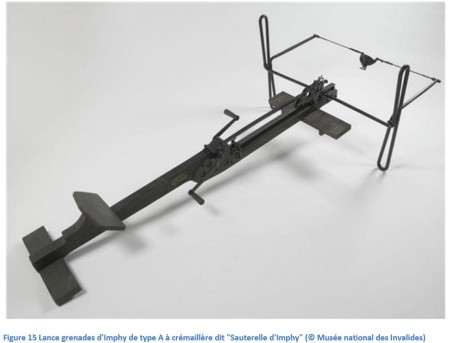 The device was designed by a French artillery officer by the name of Elie André Broca (who was also a science professor, medical doctor, and inventor in the fields of optics, dirigibles, and underwater listening devices). He took out a patent (French patent #502,158) in March of 1915. These crossbows were actually fairly sophisticated, and Broca put together a company to manufacture them. They would turn out to be fairly well-liked by troops, and did a good job of filling the technology gap until more modern light mortars could be developed and mass produced (the need for such weapons was really not anticipated when the war broke out).
The device was designed by a French artillery officer by the name of Elie André Broca (who was also a science professor, medical doctor, and inventor in the fields of optics, dirigibles, and underwater listening devices). He took out a patent (French patent #502,158) in March of 1915. These crossbows were actually fairly sophisticated, and Broca put together a company to manufacture them. They would turn out to be fairly well-liked by troops, and did a good job of filling the technology gap until more modern light mortars could be developed and mass produced (the need for such weapons was really not anticipated when the war broke out).
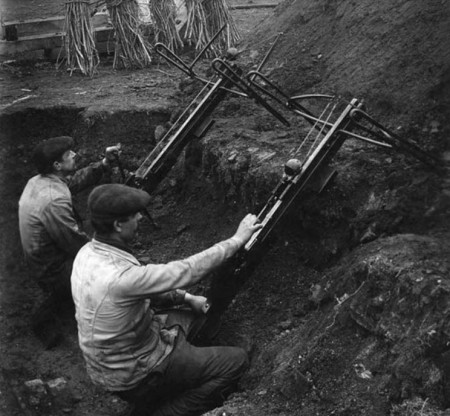
The maximum range of the Arbalete was about 125 meters. It was intended to be mounted at a 45 degree angle against a trench wall, and different ranges could be chosen by using a sliding stop on the track that the grenade and cup traveled on. That track was marked out with a scale, and the instruction plaque on the left side of the weapon specified where to place to stop for a given grenade weight and desired range. Once it was properly set, the gunner (ideally a 2-man team, but it could be operated solo) would use the hand cranks to drawn the grenade cup back to the stop. Then he would set a grenade in the cup, strike its friction igniter, and pull the release trigger on the Arbalete to let it fly. The official rate of fire was 4 rounds per minute, and the whole assembly weighed 29kg (64 lb).
I did come across a short instruction pamphlet printed for these, which you can download below. In addition, I found an excellent monograph on the subject of several types of mechanically-powered launchers like this written by Jean Michel Kalouguine. It is in French, but the illustrations are great (I swiped several in this article from him) even if you can’t read it. Lastly, we have this set of photos of the Arbalete in the Paris museum (which are much better than the one photo I took myself when I was there):
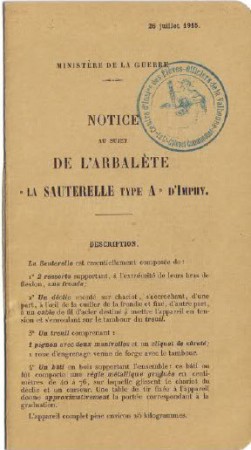

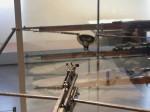
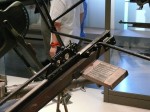
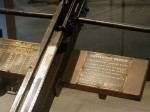
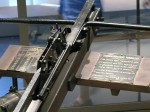
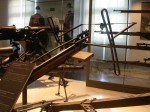
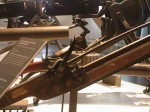
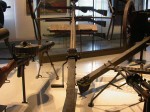
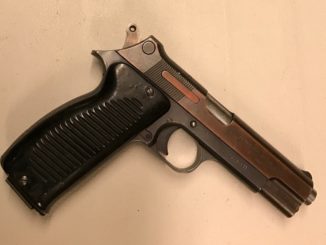

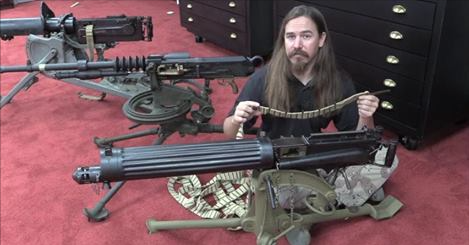
You could use something similar in a sort of golf game, mounted onto an appropriate tripod “with traverse, and elevation increments” kind of a mortar, indirect fire lark.
Might be a lark, fire over a forest onto a target laid on the ground.
You could have “vanes” on the bolts which are set to move mid flight, to increase accuracy.
Spring loaded, clockwork or something.
Or the above with golf balls, and holes… Trying to drop a golf ball into a hole with one of them would make benchrest guns boring.
I think you are right; it has to do with aerodynamics of missile(s). As you mentioned the siege machines of old ages, I recollect a documentary describing re-construction effort carried on in England od medieval “trebouget” (not sure if spelling is right). they discovered how important it was to allow the base to move on its wheels thus adding to momentum of thrown ball.
Ooops, it ended under Pdb instead under ‘eon’ where it was supposed to.
Yes, all siege engines relying on the first-class lever principle (i.e., a “verge” or throwing arm with sling or scoop) pretty much have to be allowed to either roll back or “buck up at the rear” to attain their full “cast”.
This is true even though the trebuchet (more commonly known as a “trip-gate” or “trap-gate” in Merrie England way back when) is powered by a counterweight, and the onager (aka “wild ass”, what most people think of when they hear the word “catapult”) was torsion-powered by a twisted skein of sinew, or something. (As Edwin Tunis pointed out in his 1954 book Weapons, no material modern experimenters have tried has lasted for more than a few shots before starting to break it strands.)
One peculiar member of the fraternity was the “torsion catapult” or “torsion trebuchet”. Instead of a skein or a counterweight, its verge was whipped upward by men yanking on ropes in unison.
Unlike the “regular” trebuchet, which practically had to be built on-site, and the onager, which was the size and weight of a freight wagon and usually required at least a four-horse hitch to move it, the torsion version was generally small and light enough that its crew of six or eight men could break it down into two or three sections, and carry it to where it was needed, much like a modern 60mm or 81mm mortar.
And that was about how it was used, too. The Chinese actually used these very light catapults as “field artillery”, flinging their early blackpowder munitions (“thunderclap” bombs with pottery casings that were pure blast weapons, and “thundercrash” bombs with metal casings that generated deadly fragmentation) into enemy formations and camps at ranges up to 150 yards. They were also highly effective when used against enemy craft in sea and river warfare.
Interestingly enough, while the Chinese apparently invented gunpowder, and used it not only as a bomb filing and as a propellant but also as the slow-burning fuse (“punk”) for hand-pumped flamethrowers burning “fierce fire oil” (we’d call it kerosene or gasoline today), they apparently never had “Greek Fire”, the self-igniting mixture used by the Byzantines which, due to containing both naphtha and quicklime, was self-igniting and even continued to burn on water.
Considering their use of other incendiaries and even chemical warfare (they stumbled upon “arsenical smokes” eight centuries before the British Gas Directorate re-discovered them by accident in 1917), their lack of it in their repertoire’ is hard to explain. It seems to have been the one mixture they simply never tried for some reason.
cheers
eon
Thank you for posting this, Ian. I’ve always been fascinated by “siege engines”, big or small, ancient or (more-or-less) modern.
The British had a similarly-conceived gadget, the West Spring Gun, but it worked more like a medieval onager;
http://en.wikipedia.org/wiki/West_Spring_Gun
I haven’t read the Kalouguine monograph yet, but I’m sure it’s in there somewhere. (Thanks for posting that, too.)
The L’Arbalete la Sauterelle Type A D’Imphy operates very much like a late Roman era “scorpion”, the all-metal dart-thrower that succeeded the earlier (mostly wood) ballista.
I find the range and elevation table on the left side of the stand very interesting. Its first column lists the elevations in degrees, the second lists how far it will send an explosive grenade at each elevation, the third lists the ranges for a gas grenade at the same elevations, and the fourth lists the ranges for incendiary grenades.
Those ranges are slightly greater than for the explosive grenade at the same elevation, so it’s apparent that a gas or incendiary grenade didn’t weigh quite as much as the standard explosive model. Also, the last two lists cut off at 60 degrees elevation and 100 and 120 meters range, respectively. Exactly why, I’m not sure; I see no reason why those types of grenades wouldn’t have the same delay on the time fuse. Perhaps the lighter grenades didn’t carry quite as far due to air resistance?
cheers
eon
The left column is not elevations it is the length you have to pull. you can see the marks on the photo whith the instruction tables on the center of the main piece. And the instructions on the right side say that if you whant the table to be true you have to put the whole thing at a 45° angle.
Sorry the 45° angle is explained in the pamphlet owever the instructions are :
1.never shoot it empied (probably to not damage it)
2.the device must be resting on its plank (the little one the bottom)
3.check regularily the screws tigthness (the device probably shaked a lot when fired)
4.grease from time to time everything that moves (a good advice in the trenches)
Very practical and meaningful device. I like the “Table de Tir” since the ‘tir’ actually means ‘throw’ and that is what it does. Saves propellant and keeps troops fit. Germans must have been surprised with this ‘quiet rain’.
Well I’d like to play “golf” anyway.
I know there was trench warfare and “trench warfare” in various parts of the western front, but still – those soldiers in the first photo seem awfully clean and unharrassed for being where they apparently are. REMFs in a training location, maybe?
It must have been relatively silent.
Denny beat me to that observation.
The modern (assume that mean time after inventing smokeless powder in 1885) high angle artillery was during the Russo-Japanese of 1904-1905 in the Siege of Port Arthur. It’s success leads to develop high-angle firing guns in Germany.
But the France in the begin of 20th century believe in the 75mm guns modele 1897, but it was almost useless against entrenchments, so the French must use older guns De Bange system (without recoiling mechanism).
—
During WW1 all sides needed “pocket artillery” – light enough to be transportable in muddy conditions and with high-angle trajectory to throw shells in to enemy trenches. The older was used (French Army used even Mortar of Coehorn system, model 1838, called by troops “Louis Philippe”) and the untypical guns also were developed like mortars utilizing air pressure (for example Austrian “Lufrminenwerfer”-s).
Even the British got out some fairly “veteran” ordnance early on. According to Hogg (Grenades & Mortars, p.75), when the British Army Trench Mortar Service was formed up at Pont du Hem near Estaires on 26 Nov 1914, their first issue was a pair of 6-inch ML mortars, one cast at Breguet in 1848 ad the other cast at Toulouse in 1842. They were assured that both had served with distinction and were entitled to the Crimean Medal with clasp “Sebastopol”. They were later “augmented” by an 8-inch of equal “seniority”.
Projectiles were Crimean spherical shell, loaded with black powder. Propellant was loose blackpowder, fired by a mining detonator stuck into the vent and set off (from a safe distance) by an electric dynamo. After which, if it fired, the mortar had to be collected from wherever it had deposited itself, the vent cleaned out (often requiring a brace and bit), and the drill repeated.
Using the correct caliber of bomb in the 6-inchers, they could reach out about 300 yards. Apparently the 8-inch somehow rendered itself unusable after a few days, because Hogg mentions that the detachment also fired 8-inch bombs from the 6-inchers by putting a piece of wood down the bore like the “stalk” on a “toffee-apple” mortar, balancing the 8-inch bomb on the muzzle with some wood props to keep it there, and touching it off. This lashup reached out about 80 yards.
On the whole, they’d probably have rather had a trebuchet or ballista. When you see the variety of gadgetry that passed for “trench artillery” early on, it’s no wonder they knighted (Sir) Wilfred Stokes of Ransomes & Rapier Engineering, Ltd., after he invented his simple but almost foolproof “bomb thrower”.
cheers
eon
Also Russian Empire used Coehorn mortars.
(source in Russian: http://ww1.milua.org/rgladmortira.htm)
Even more, the ГАУ (Main Artillery Directorate) ordered 500 new 6-pounder mortars in February 1915. But after the prototypes trials the order was annulled.
Following sizes of Coehorn mortars were used in Russian Empire:
1/2-pounder model 1838 produced until 1878. In 1915 the 144 of this gun were still listed as armament of fortress in West Russia.
2-pounder
5-pounder
6-pounder
8-pounder, bore diameter: 107mm, this size was most popular, launch 3kg shell (“grenade”) containing 150g (i.e. 0,15kg) of blackpowder, with maximum range of 650m.
A simple and ingenious mechanical grenade thrower with very few moving parts and which could probably be easily repaired if needed with easily-available materials scrounged from the local scrap yard.
Thanks for the wonderful post, Ian — I think you’ve actually outdone yourself this time in revealing the existence of a truly forgotten weapon in detail.
I would love to have one of these as well as a British 1914 Leach Trench Catapult.
If my calculations are correct, that 1 kg grenade produces about 450 foot pounds of kinetic energy.
Not too shabby, it would definitely hurt if it just hit you without exploding.
There was also an experimental WWI rotary grenade launcher that I have read about. Pretty sure I wouldn’t want to be part of that crew.
In The Guns 1914-18 (pp.74-75), Hogg mentions a couple of these gadgets;
It’s worth noting that such mechanisms still show up now and then today. Usually in connection with attempts to build perpetual-motion machines.
Trivia note; A perpetual-motion machine is the only device for which the U.S. Patent Office still requires that a working model be submitted along with the patent application. No fools, they.
😉
cheers
eon
The article in wikipedia: http://en.wikipedia.org/wiki/Sauterelle
states that Sauterelle mean “grasshopper”.
I just realized that the “springs” (or “prod” or “lath”) that provide the flinging force are the strange vertical loops of metal rod, not the short horizontal rods. They are essentially folded torsion bars. Do I have that right? I was staring at the pictures for the longest time, wondering how those short horizontal pieces could bend 90 degrees backwards without breaking.
Do any other crossbows use a torsion spring principle (other than the old ballistas, I mean)? Does this kind of folded long torsion rod work better than a coiled torsion spring?
Hey the monograph link appears to be dead. I shared this page and someone found this which we believe to be the original document.
https://www.kalasnyikov.hu/dokumentumok/lance_grenade_de_tranchee.pdf